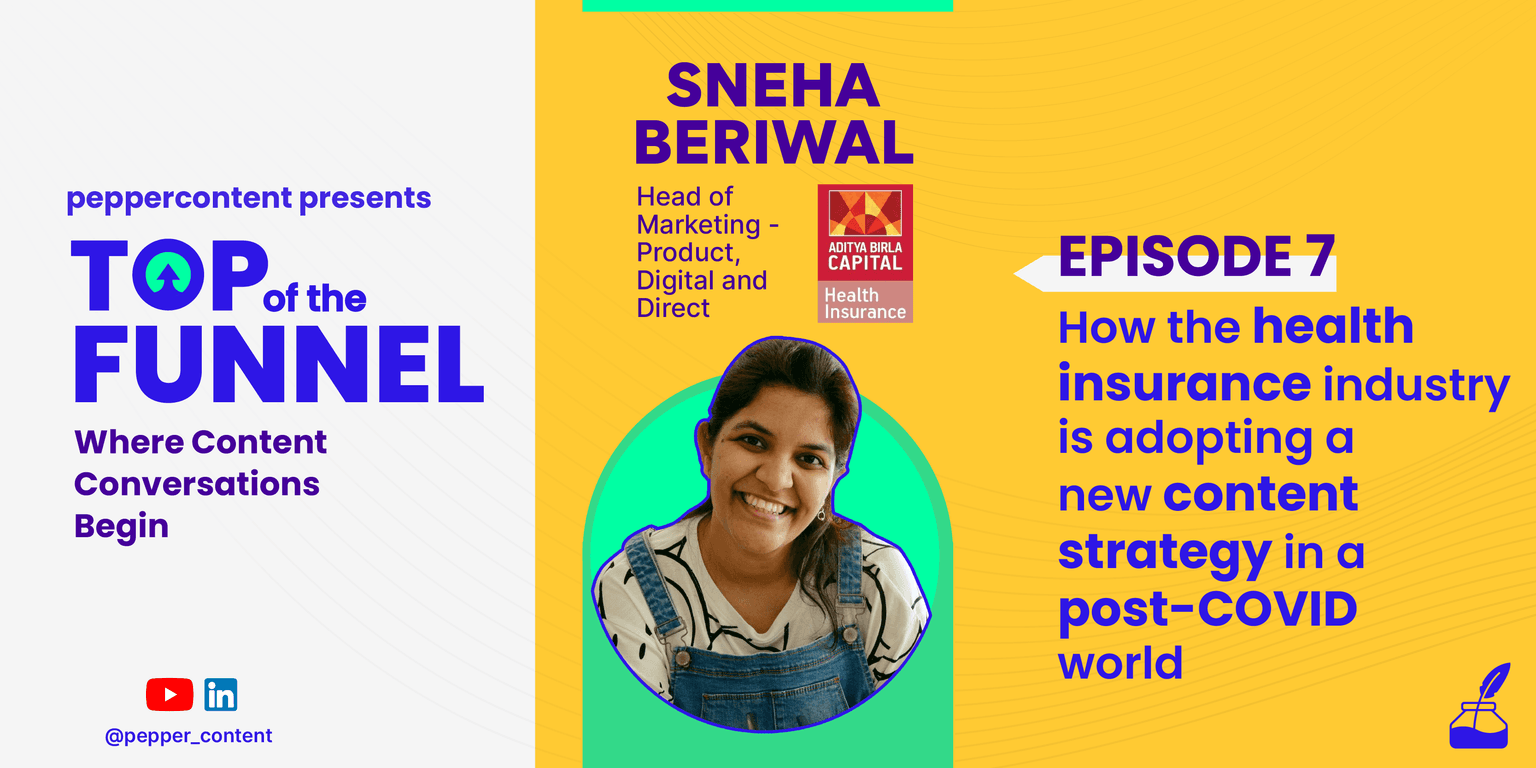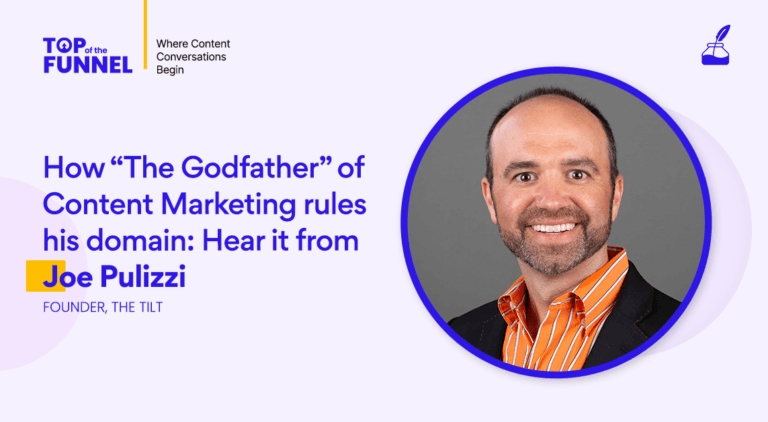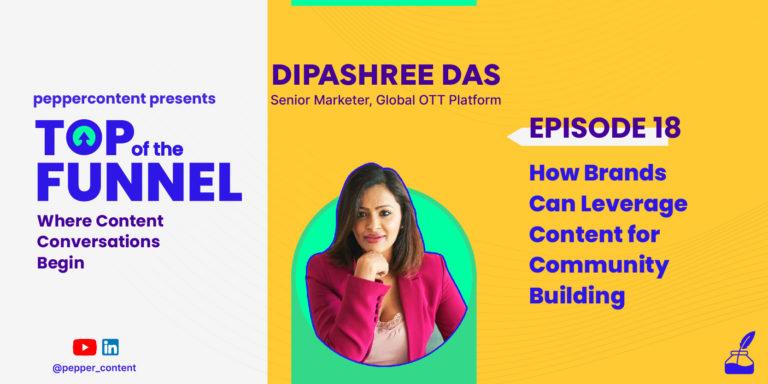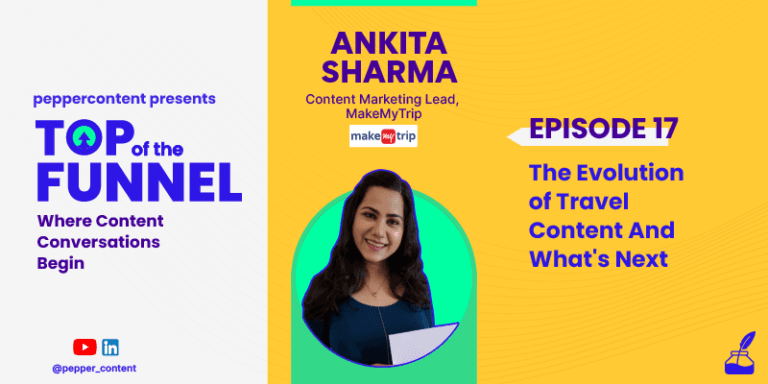Episode #7: How the Health Insurance Industry is Adopting a New Content Strategy in a Post-COVID World

The pandemic has changed the entire face of the health insurance industry. The public is much aware of health terminologies and is actively making use of the upcoming digital platforms to get answers for their queries. Several people lost their jobs, thereby losing the security blanket of corporate health insurance. And, health insurance companies have jumped to the aid of the common people by providing lucrative personal insurance offers.
Natasha Puri, Content Marketing Lead at Pepper Content, talks to Sneha Beriwal, the Head of Product, Digital, and Direct Marketing at Aditya Birla Health Insurance Company Ltd. about her career trajectory, the evolution of digital marketing, and the role of content marketing in the health insurance industry, especially in the post-Covid world.
Having had an extensive career in FMCG companies like Dabur and Nestle to working in digital payments, retail, and finally health insurance, Sneha Beriwal has seen the evolution of digital marketing across all industries. Her marketing principles are rooted in one belief- the consumer is the heart of everything. A strong passion for marketing, coupled with a hunger for learning has allowed her to adapt and excel across diverse industries.
Natasha Puri: Hello everyone. Welcome to the Top of the Funnel, the series where conversations about content begin. I’m Natasha, the content marketing lead at Pepper, and our guest today is the Head of Product in Digital Marketing at Aditya Birla Health Insurance, Sneha Beriwal. From Nestle, Dabur, and now the Aditya Birla Groups, she has held multiple positions across industries. Today, we dive into her career as a marketer and how the role of content has changed in all these years.
I’d love for you to talk about your journey as a marketer and outline those transitions.
Sneha Beriwal: I started my marketing career in FMCG, and ever since, I have worked with brands like Nestle and Dabur. I was lucky to get a chance to work abroad for around five years. When you work in a different geography, you always learn additional skills. And, I got to learn design aesthetics and minimalism. I feel privileged to learn those trends firsthand.
After my FMCG stint, I moved back to India. I’ve been with Aditya Birla Group for about four years now. And it has been a wonderful experience because I got the opportunity to work across multiple businesses. I joined hands with a digital payments business. I also supervised a campaign for one of our largest retail brands. Right now, I am working on consumer marketing for Aditya Birla health insurance. We are one of the six standalone health insurance players in the country, the youngest and the fastest growing; so, it has been an exciting journey.
When I think of my career transition, how does it work when you move across industries? The one thing I’ve realized is that if you keep the consumer at the core of your thinking, and keep your pocketing principles intact, then scalability across industries is not a challenge. You just need to have an open mindset.
When you go into a new industry, be open to tremendous learning. I also feel that I can solve problems better because I have had such a diverse range of solutions throughout my career. I am a curious person, and the switch across industries keeps me interested, motivated, and keeps me going.
Natasha Puri: How has the role of content changed in all these years and across these sectors?
Sneha Beriwal: Looking at content throughout my career, I’ll put it into four broad buckets. There was a time when content was all about crisp storytelling. You had to tell sharp stories quickly and get to the point. Then, the digital era started. Suddenly, the constraints went away, and we started curating long-form stories, where there was more detail. The canvas for storytelling through content opened up. That was the onset of the digital era. Then, there came a time when just having a good story was not good enough. It needed innovation as well.
And, this led to video content curation, influencer marketing, and general marketing. Feeding content in this era is tough. We have to put it out there so deliberately that it doesn’t look like conventional content. Content is trying very hard not to be content. It’s trying to disguise itself as an advertorial, or something that does not come across as branded content.
Now, there is influencer marketing, partnerships, etcetera. It’s interesting because it is all about hearing the influencers’ or the endorser’s view on the brand. This also overlaps with how the customer has changed. The consumer is well informed. They are seeking more information that is usable, shareable, and valuable.

Natasha Puri: Can you throw light on the role of content specifically in this industry, and what is your content strategy?
Sneha Beriwal: BFSI, as a category, has not been in line with the overall speed at which content has evolved in our world. This is due to the slightly complex nature of the category. It has hard-to-understand terms and concepts. So, the need for content is even higher. I feel the brands are catching up. For us, content is very important in what we do. We believe in keeping customers at the heart of everything that we do. And when you think from that philosophy, your communication and content have to come from a space that adds value to the customer’s experience.
Health and insurance are, unfortunately, very low mindshare categories in this country. Everybody’s thinking about it, but nobody’s doing a lot about it. Insurance, in itself, is a very low mindshare category. So our biggest challenge is that we are dealing with two words that don’t create an automatic pull. And that is why the job of the content becomes more crucial. We always try to do things differently.
Our blog, community, and interest group are big pillars of the content we leverage at ABHI. Apart from that, we try to simplify our product communication, mostly through explainer videos. We aim to bust the myths around insurance. But we are always within the realms of regulation. We do not want any miscommunication to hinder our customers’ experience and learning. More importantly, we focus a lot on creating topical content.
Grabbing a customer’s attention is always a win. They may not buy a product or engage with it, but keeping them informed is a win in itself. Setting up a vaccination Q&A helpline, a do’s and don’ts series, workout ideas at home, etcetera are created from a perspective, which is always relevant to the customer. We believe that if they’re engaging with the right conversations, with the right larger audience, whenever they’re thinking of insurance, they will think of us as the top brand of choice.

Natasha Puri: I’d like to ask what certain metrics are important to you in the content business? What are the metrics you’re looking at? What are you hoping to drive out of that huge piece of content you create at scale?
Sneha Beriwal: Calculating ROI from content is tricky, but we track some larger marketing KPIs. We believe that content plays an important role in organic search. Organic search volume comes from our customers and the people, who are seeing the educational content we are putting out. This is drawing people to search for us. So, organic search is a huge element for us. We also look at our content’s engagement, especially when we put it out on social media. We answer questions the people want to know. We track the likes, comments, shares and address those queries. That is the second KPI to track.
The third KPI could be that whenever we put out a big piece of content or campaign, we try to do a brand lift study on YouTube or Facebook. That gives us immediate output from the campaign. We do run a brand track. Over time, we see the impact of all the communication being put out there. We track the brand in terms of consideration and awareness.
We are an on-ground, heavy business because a lot of insurances are ultimately sold by the agent. So, for us, there is a constant feedback mechanism that operates on the field. We get to know what is working and what is not.
These are some of the indicators that we track. Putting one dollar ROI to every dollar of content is tricky. If you start focusing too much on the dollar ROI on content, it will cripple the creativity that content can bring to the business. So, we try to be pragmatic and balanced about it. But we are a business, so we track these broad KPIs to ensure that we are headed in the right direction.
When it comes to community and blog engagement, it is the largest KPI that we track. Engagement can be in terms of repeat visitors. It can be in terms of people who subscribe to it; it can be in terms of the time a person spent on watching our content, or the content consumed person, number of content, etcetera. These are all the typical content KPIs that can be tracked for our blog and communities. So far, we have seen organic traffic do not immediately convert a visitor into customers. We track that as a lag metric over time. We also want to start thinking of new ideas because we do not want our community as just customers but also as brand advocates. When people are engaged with the brand, they become great brand ambassadors as well. So, their hearty engagement helps us keep our content useful and centralized.

Natasha Puri: In the overall marketing landscape, what is your content pillar? How is the marketing team structured at ABHI?
Sneha Beriwal: A marketing team has a foundation, a roof, and three pillars. The three pillars are: How do you inform the customer? How do you acquire the customer? How do you engage with the best of them?
The Pillar one is awareness, driving on top of the mind. Pillar two is a more targeted, focused function, which talks about sales, channel visibility, and performance marketing for a digital product. Pillar three means different things for different businesses. For us, engagement means renewables. But, when I was in the retail business, engagement meant repeat customer visits. How many times did the customer visit my shop in FMCG? So, different businesses have different things, but engagement is the third pillar.
Every content marketing team should have a strong foundation in content. Whether you are informing, acquiring, or engaging, every function needs to have a very strong content understanding. And the roof of a marketing team is the breadth of media that is available. Whether it’s TV, radio, digital/in-store visibility, etcetera, all kinds of media binds everything together for the customer.
Whenever you see a house, the foundation is never seen. It just appears as an underline. But that doesn’t mean that it can be weak. After all, the entire building is standing upon it. So, the content must be immaculate. Now, the roof is the most exposed part of a house. So, it must be made up of the most suitable elements. In my view, this is how every marketing team should be structured.
Natasha Puri: How has the role of content and the demand for strong content changed? How has the dynamic essentially impacted your campaigns?
Sneha Beriwal: The pandemic has changed a lot of things. Health insurance has become important in this country for the first time. The category is seeing serious push. This is a big shift that is happening right now. Since everything has gone digital, so did the marketing. Our dependence on physical sources of media has decreased by many folds. You can reach more people digitally. You can put up a variety of messages, or content out there. It doesn’t have to be as similar as the previous month. I will only drive my message forward. So from that perspective, I think the pandemic has opened up opportunities. We were able to scale up very quickly. All the demand that we see for our category fits well with the available educational information. We are turning in new educational information pretty much every week. The pandemic has added a lot of health words to people’s vocabulary. I’m so lucky to be writing about raising awareness for such a category.
As a leading brand, we are putting content out there, answering people’s questions. It is a great plug for us to start pitching our brand as a solution-oriented brand and helping people understand the complexity of the current situation. We were pleased to ride on this opportunity because of our already existing focus on digital content as a business.
One of the things that became pretty clear early in the pandemic was the potential job loss for millions of people. A lot of salaried people avail themselves of employer health insurance. In the pandemic, if you were unfortunate and lost your job, you were not just out of income, you were also without health cover. So, it was almost a double hit, and many didn’t realize it until critical crises hit them. But, we used that as an opportunity. We launched a campaign specifically targeted to the salaried segment saying that they should not get comfortable with corporate insurance care. Personal health insurance will hold up even after their job.
Most people don’t even realize that their covers are mostly three to five lakh rupees. If you’ve heard stories of COVID hospitalizations for the family, most of them ended up using their personal savings. Our campaign was focused on two reasons, ownership of one’s health insurance, and the adequacy of their insurance. This was one of the campaigns that we put out regarding health insurance.
On-ground distribution people are the best regarding feedback. They give us the feel of the market and the continuance as well. We track KPIs too. We see a percentage jump in the product. Our campaigns have video assets, so the video reach and engagement becomes an important KPI. We also drive a lot of partnerships in a campaign to drive leads or traffic to the website. It ends up becoming an important KPI and not just a lead.
We track the whole funnel in terms of lead visits to lead inquiry to conversion. And, if they do not convert, we review what went wrong. It gives us great insights for thinking of the next campaign. Was it the pricing that they didn’t like? Did we not cover a particular hospital that is close to their home? So, we delve into the reasons for non-conversion too. They are as important as understanding the numbers of conversion.
Natasha Puri: As someone who’s worked across various industries, what do you think the future of content marketing is?
Sneha Beriwal: There are three futures, the now, the mid-term future, and the long-term future. The ‘now’ of content marketing is the 3Vs framework that we’ve all talked about: voice, vernacular, and video. Businesses have started on the journey. Are we there yet? The answer is no; there’s a lot more that needs to be done on voice and vernacular, than on video. And in the near future, that is what is going to keep them in business.
The only way content will exist will be hyper-personalized. What you see will always be different from what I see. This ‘one size fits all’ strategy will completely go away. So that’s what I think is the mid-term future. It is going to be highly personalized and highly contextual.
In the long-term future, we don’t even know what kind of content will exist then. And I’ll give you an example, voice as a piece of content didn’t exist a few years ago, right. And then Alexa and Google homes happened. And suddenly, that concept exploded. We had not heard of podcasts. Look at how well podcasts are doing today.
We only need to keep ourselves updated on the new device innovations and figure out the right content to be delivered on that unique device. New content formats will come into play. And as marketers, we need to constantly ask ourselves these questions so that, we can be ahead of the curve rather than chasing the ghost. Things are moving fast. We don’t know which is a long-term trend. How long it will stay? What exactly are we supposed to do with it?
Natasha Puri: Thank you so much for joining us, Sneha! This was an insightful conversation.
Latest Blogs
Explore how Google’s 2025 AI search updates triggered ranking chaos. Learn actionable strategies to adapt your SEO for AI Overviews, zero-click searches, and SERP volatility. Stay ahead now.
Learn how to rank on AI search engines like ChatGPT, Perplexity, and Gemini by optimizing your content for authority, structure, and relevance. Stay ahead in AI-driven search with this strategic guide.
Explore the best healthcare SEO services for your medical practice. Improve online visibility and effectively reach more patients in need of your services.
Get your hands on the latest news!
Similar Posts

Expert Speak
18 mins read
Season 2 Episode #1 How “The Godfather” of Content Marketing Rules His Domain: Hear It From Joe Pulizzi

Expert Speak
16 mins read
Episode #18: How Brands Can Leverage Content for Community Building

Expert Speak
11 mins read